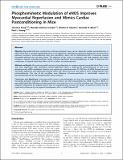Phosphomimetic Modulation of eNOS Improves Myocardial Reperfusion and Mimics Cardiac Postconditioning in Mice
Author(s)
Pong, Terrence; Scherrer-Crosbie, Marielle; Atochin, Dmitriy N.; Bloch, Kenneth D.; Huang, Paul L.
DownloadPong-2014-Phosphomimetic modul.pdf (2.005Mb)
PUBLISHER_CC
Publisher with Creative Commons License
Creative Commons Attribution
Terms of use
Metadata
Show full item recordAbstract
Objective:
Myocardial infarction resulting from ischemia-reperfusion injury can be reduced by cardiac postconditioning, in which blood flow is restored intermittently prior to full reperfusion. Although key molecular mechanisms and prosurvival pathways involved in postconditioning have been identified, a direct role for eNOS-derived NO in improving regional myocardial perfusion has not been shown. The objective of this study is to measure, with high temporal and spatial resolution, regional myocardial perfusion during ischemia-reperfusion and postconditioning, in order to determine the contribution of regional blood flow effects of NO to infarct size and protection.
Methods and Results:
We used myocardial contrast echocardiography to measure regional myocardial blood flow in mice over time. Reperfusion after myocardial ischemia-reperfusion injury is improved by postconditioning, as well as by phosphomimetic eNOS modulation. Knock-in mice expressing a phosphomimetic S1176D form of eNOS showed improved myocardial reperfusion and significantly reduced infarct size. eNOS knock-out mice failed to show cardioprotection from postconditioning. The size of the no-reflow zone following ischemia-reperfusion is substantially reduced by postconditioning and by the phosphomimetic eNOS mutation.
Conclusions and Significance:
Using myocardial contrast echocardiography, we show that temporal dynamics of regional myocardial perfusion restoration contribute to reduced infarct size after postconditioning. eNOS has direct effects on myocardial blood flow following ischemia-reperfusion, with reduction in the size of the no-reflow zone. These results have important implications for ongoing clinical trials on cardioprotection, because the degree of protective benefit may be significantly influenced by the regional hemodynamic effects of eNOS-derived NO.
Date issued
2014-01Department
Harvard University--MIT Division of Health Sciences and TechnologyJournal
PLoS ONE
Publisher
Public Library of Science
Citation
Pong, Terrence, Marielle Scherrer-Crosbie, Dmitriy N. Atochin, Kenneth D. Bloch, and Paul L. Huang. “Phosphomimetic Modulation of eNOS Improves Myocardial Reperfusion and Mimics Cardiac Postconditioning in Mice.” Edited by Philip Michael Bauer. PLoS ONE 9, no. 1 (January 21, 2014): e85946.
Version: Final published version
ISSN
1932-6203